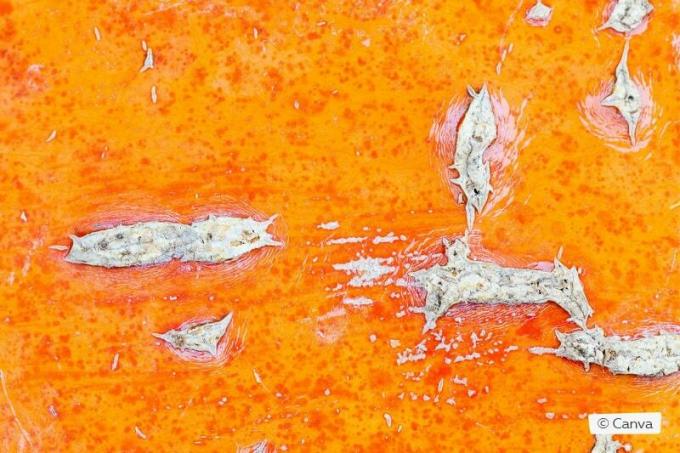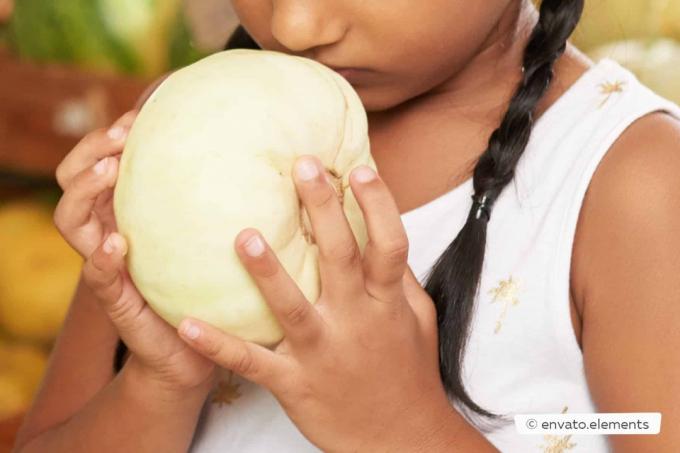
Pumpkins are ideal autumn and winter vegetables, after all they can be stored for a very long time. But even a pumpkin sometimes goes bad and develops brown spots. Can you still eat it then?
In a nutshell
- Simply cut away brown spots on the outer skin, provided the flesh is flawless
- Do not eat brown or black flesh if there is a foul smell
- brown spots are caused by incorrect storage or overlaying
- ensure cool, dry storage
- Only store fully ripe pumpkins
Table of contents
- Brown spots on shell
- Brown spots in the flesh
- Causes of brown spots
- prevent staining
- frequently asked Questions
Brown spots on shell
Whether a pumpkin with brown spots is still edible depends primarily on the location of the dark spots and the overall condition of the affected fruit. Are the brown spots only on the shell, so you should cut open the pumpkin and check the pulp. If this is intact and smells pleasant, simply peel the pumpkin and use the pumpkin flesh as usual. On the other hand, if the fruit smells rotten, it is bad and can no longer be eaten.

Tip: Do the tan spots on the skin feel hard and are they localized to a specific region? Then it is just a lignified bruise on which the fruit rested on the ground. You can simply cut these away.
Brown spots in the flesh
However, if the brown spots are already visible on the inside of the pumpkin, it is usually due to rot. You can simply cut away small areas and still eat the fruit, as long as the pulp smells and tastes pleasant. To do this, cut off a small sample and try it – does it taste slightly like pumpkin or does it have a slightly unpleasant rotten taste? In the latter case, the whole fruit must be discarded.

This also applies if
- large parts of the flesh are discolored brown to black
- the flesh is not firm but soft to mushy
- the kernels are brown and mushy or even mouldy
- the fruit smells unpleasant when cut open
Causes of brown spots
In general, pumpkins have a long shelf life. Many types of pumpkin you can easily store for several months, such as the popular ones Hokkaido pumpkin. The nutmeg squash stays fresh for up to a year. However, this only applies if you get the fruit
- harvest fully ripe
- let it harden well
- and store properly
Harvested immature or improperly stored pumpkins begin to rot prematurely, which is reflected in the formation of spots. Sometimes the garden crops will also develop white, furry mold, which can form both inside and outside. Furthermore, the brown spots form when the pumpkin is simply layered. In this case, that means you just let it sit too long. Even vegetables that can be stored well, such as pumpkin, do not keep indefinitely, but will eventually go bad.

Tip: In addition to Hokkaido and Nutmeg Squash, the butternut squash, the turban pumpkin and the giant pumpkin (also known as giant hundredweight) as well storable. However, the latter keeps fresh for a maximum of three months. Spaghetti squash, on the other hand, can only be stored for a short time and must be processed shortly after harvest.
prevent staining
With the right storage, you can prevent the premature formation of brown spots on the pumpkin. However, you should only store fully ripe, well-cured fruit, which you can recognize by these characteristics:
- hard, woody stem
- species-typical coloring without green spots
- sound hollow when counter-knocked
In addition, you should only leave pumpkin varieties that can be stored for longer and observe these conditions for optimal storage:

- Do not wash squashes before storing
- select only perfect and undamaged specimens for storage
- store in a dark and cool place at 10 to 12 °C
- Basement rooms ideal
- Pay attention to dryness, moisture promotes rot and mold
- Store fruit individually on straw, do not stack
- ensure good ventilation
A notice: Also note that the shelf life of the fruit is reduced the warmer it is. At room temperature, all pumpkins quickly develop brown spots.
frequently asked Questions
If a pumpkin has green spots, it is simply not fully ripe. These places are not poisonous and can be eaten without any problems. However, unripe fruits do not taste really aromatic, which is why you can simply cut out these areas.
Care should also be taken with mold! If moldy spots appear on the pumpkin, it is best to throw away the whole fruit. The fungal threads – called mycelium – may already be invisible and run through large parts of the meat. The fungal toxins it contains can cause serious damage to health.
If you grow pumpkins in the garden yourself, you should pay more attention to the taste of the fruit. Cucurbits can develop potentially deadly toxins, but fortunately they are characterized by an extremely bitter aroma. Bitter-tasting gourds, including zucchini, melons, and cucumbers, so you should never eat it, but dispose of it immediately!
